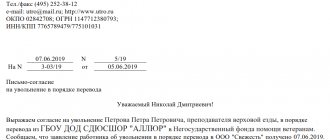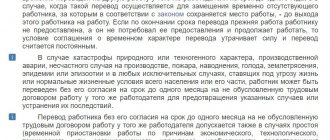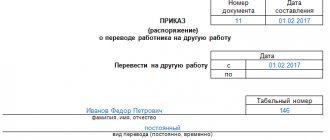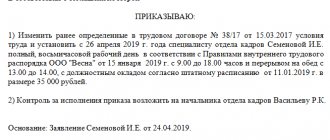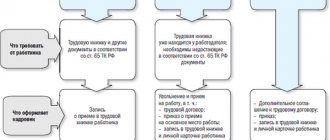The transfer of employees to remote work can be carried out at the request of the employee or employer, but by mutual agreement. The Labor Code of the Russian Federation does not stipulate specific reasons for this. If the employment contract with an employee does not indicate the possibility of working remotely, then an additional agreement on transfer to remote work must be drawn up.
- Form and sample
- Free download
- Online viewing
- Expert tested
FILES
Reasons for remote transfer
The Labor Code does not indicate when it may be necessary to transfer an employee to remote work; this issue remains at the discretion of the employer. The relocation is formalized if an employment contract was not initially concluded for the remote nature of the work, but a need arises for it, or the parties reach an agreement on the possibility of a specialist performing labor functions outside the location of the organization.
A temporary transfer, in accordance with the amendments made to the Labor Code of the Russian Federation FZ-407 and coming into force on January 1, 2021, is possible in the event of force majeure circumstances for the duration of their effect. When moving to remote mode on the initiative of the employee or by agreement of the parties, an additional agreement is signed; temporary movement is carried out without the consent of the employee.
ConsultantPlus experts discussed how to transfer an employee to another position. Use these instructions for free.
In remote work, interaction between employee and employer occurs through telecommunication networks. Remote document flow is organized according to the rules specified in the employer’s local regulations. Issues of working hours, interaction, employee communication, control over the performance of work duties are determined in the employer’s local regulations. The Labor Code of the Russian Federation from 01.01.2021, in accordance with current amendments, allows the parties to regulate these conditions in internal regulations, rules, etc.
Types of remote work:
- on a permanent basis, when the employment contract is concluded in order to work remotely;
- temporary remote work, when an employee switches to remote work for a certain period (no more than 6 months);
- combined remote work, when alternating stationary employment at the workplace (office) and remote work.
Forced transfer
In addition, the Labor Code also provides for an option when an employee is forcibly transferred to remote work for a certain time
in exceptional cases. This may happen if:
- the decision on the transfer was made by a state authority or local government;
- when the life or normal living conditions of the population, or parts of it, are under threat (for example, in the event of a natural or man-made disaster, fire, flood, earthquake or in the event of an epidemic).
With the option of forced remote work in exceptional cases, obtaining consent to the transfer from the employee and making changes to the employment contract is not required
. It is enough to develop a local normative act taking into account the opinion of the primary trade union.
It must indicate:
- reason for emergency remote work;
- transfer deadline;
- list of employees.
Such a regulatory act may be called the Regulations on Remote Work. His task is to explain the situation to employees and familiarize them with changes in the work of the enterprise.
(See an example of such a provision).
Who can be transferred to remote work
However, the specialist whose work function is not directly related to being on the employer’s premises is transferred to the remote process. For example, HR officers, lawyers, secretaries—those employees whose functions are related to document processing—will be able to work remotely. It will not be possible to transfer cleaners, watchmen, workers, etc. to remote work.
Transfer procedure
We prepare the translation
To transfer an employee to remote work, conduct an audit of the technical capabilities of the organization and the specialist himself. It is necessary to ensure that production facilities are available at the potential workplace or to provide additional resources. Make lists of those you plan to transfer to remote work. Decide on the organization of the process: work and rest schedules, interaction patterns, methods of control, develop and adopt a local regulatory act.
In accordance with the Labor Code of the Russian Federation, the main stages are defined for how to transfer an employee to remote work:
- drawing up a statement or consent (exception - temporary transfer);
- signing of an additional agreement;
- publication of an order for the enterprise.
An application for switching to a remote mode is drawn up in free form, the employee expresses a desire to work remotely, indicates the reasons, the date from which he wants to switch to the new mode, the parties agree on the conditions, and the manager endorses the application. Temporary transfer is carried out on the basis of an order from a government agency, the publication of a law or decree, or an order on the occurrence of an emergency situation.
The main significance when moving an employee with whom an employment contract has already been concluded to remote mode is the additional agreement. It defines a new procedure for interaction for the parties, rules for document management, or makes reference to a local regulatory act and the fact that the worker has become familiar with it.
Here is an example of an additional agreement for remote work (blank form):
| Additional agreement No.__ to the employment contract dated ___________ No. 1-TD |
Limited Liability Company "_____", hereinafter referred to as the "Employer", represented by General Director _______, acting on the basis of the Charter, on the one hand, and ____________, hereinafter referred to as the "Employee", on the other hand, have entered into this additional agreement to the employment agreement dated _________ No.__ on the following:
1.1. Add to section “1. Subject of the agreement" of the employment contract, clause 1.3 as follows:
"1.3. The work performed by the Employee under this employment contract is remote, that is, the Employee performs duties outside the location of the Employer, its branch, representative office, outside a stationary workplace, territory or facility under the control of the Employer, provided that it is used to perform this job function and for interaction between the Employer and the Employee of public information and telecommunication networks, including the Internet.”
1.2. Amend clause 1.4 of the Employment Agreement as follows:
"1.4. The employee performs the duties assigned to him by the employment contract in accordance with the Rules set out in the Regulations on Remote Work, which he is familiarized with separately. The place of work is determined by him at his own discretion.”
1.3. In paragraph “6.2. Responsibilities of the employer" of the employment contract, add points:
"6.2.9. Every month, no later than the 15th, reimburse the Employee for expenses incurred for the Internet and mobile communications, based on the supporting documents submitted by the Employee.”
1.4. Amend clause 4.1 of the employment contract as follows:
"4.1. The Employee’s working hours and rest hours are established in accordance with the internal labor regulations _____________. By agreement with the manager, the Employee has the right to change the working hours, subject to mandatory compliance with the actual working time of 40 (forty) hours per week.”
2. Other terms of the employment contract not specified in this additional agreement remain unchanged.
3. This additional agreement comes into force on _________.
4. This additional agreement is an integral part of the employment contract, drawn up in two copies having equal legal force. One copy is kept by the Employer, the second by the Employee.
| Worker: | Employer: |
We draw up an additional agreement
The second step after signing the consent is the need to draw up an additional agreement on transferring the employee to remote work; this is regulated by Art. 72 TK. The basis for its conclusion will be the employee’s statement, proposal or initiative of the employer. It is recommended to provide important nuances:
- Workplace. It is difficult to define it precisely within the meaning of the law - “outside the location of the employer.” It is advisable to think about whether this specialist is needed in the office, on what days, and document this. It is allowed to both indicate the place of work of a remote worker in the employment contract in the form of an indication of the locality, and leave it at the discretion of the employee (from any location). But in accordance with changes to the Labor Code of the Russian Federation, the employer reimburses the employee for all expenses associated with performing duties remotely. And he gets the right to fire a specialist if he moves to an area where there are no conditions for remote work.
- The employee sets his own working hours. If the employer has any requirements, for example, to be on call from 9:00 to 17:00, these should also be stated in the agreement. It makes sense to indicate the length of the working week and weekends.
- Mechanisms of interaction and methods of control.
- Use of employee resources and payment of compensation.
The more detailed you are about the conditions for working remotely, the less likely you are to encounter misunderstandings, negligence or abuse on the part of both the employer and the employee.
We issue an order
The decision is formalized by an administrative act. The order is issued after an additional agreement on remote work with the employee is signed. There is no approved form; the document is drawn up in free form. It is allowed to use the T-5 form or use a self-developed form. The order is issued on company letterhead, or the details (name, TIN) are a separate part of the form.
The order reflects the fact of moving remotely, the start date of the regime, the employee’s data (last name, first name, patronymic, position, department, structural unit), indicates a link to the additional agreement, the basis - the employee’s statement or the employer’s initiative. The employer is prohibited from changing the salary when switching to remote work, if the scope of responsibilities remains the same. The employee is presented with the order against signature.
What to write in an additional agreement
The first thing you need to understand is that an additional agreement on remote work does not change the employee’s scope of responsibilities, it clarifies the place where they are performed. If previously the workplace was located in the employer’s office, then after the transfer it is located outside the employer’s location, for example, the person’s home address, from where he will actually start working.
In addition to the workplace, the parties have the right to stipulate:
- new work and rest regime;
- methods of interaction and control;
- duration of remote employment;
- the procedure for paying wages if they were previously paid out from the cash register;
- other details.
Sample additional agreement on transfer to remote work
IMPORTANT!
Remote workers are subject to all the guarantees that exist for other workers. Depriving remote workers of annual paid leave, time off for work on days off, benefits or other rights is an administrative offense.
Read more: What you need to know about remote work
How to get an employee back from a remote location
In the additional agreement, include a clause about the end of the remote period if you plan on its temporary nature, or the possibility of extending the validity period. If you know exactly how long you are transferring employees to work remotely, indicate the start and end dates of the remote mode in the order. In accordance with changes to the Labor Code of the Russian Federation, from 01.01.2021, a combination of remote and office work (combined mode) is allowed, when periods of work in and outside the office alternate.
In the organisation




